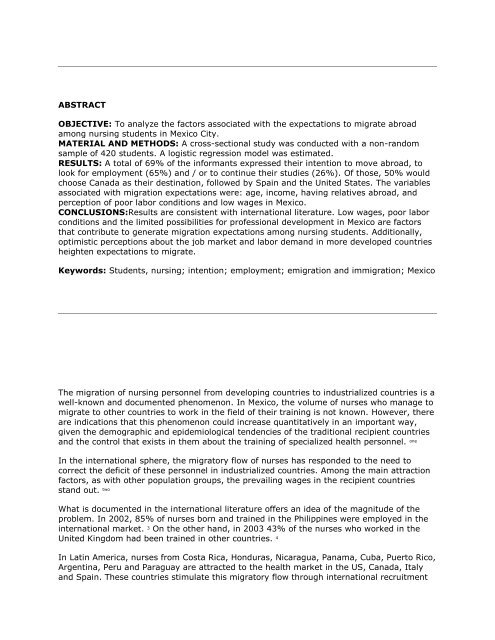Expectations of international migration in nursing students in Mexico
Create successful ePaper yourself
Turn your PDF publications into a flip-book with our unique Google optimized e-Paper software.
ABSTRACT<br />
OBJECTIVE: To analyze the factors associated with the expectations to migrate abroad<br />
among nurs<strong>in</strong>g <strong>students</strong> <strong>in</strong> <strong>Mexico</strong> City.<br />
MATERIAL AND METHODS: A cross-sectional study was conducted with a non-random<br />
sample <strong>of</strong> 420 <strong>students</strong>. A logistic regression model was estimated.<br />
RESULTS: A total <strong>of</strong> 69% <strong>of</strong> the <strong>in</strong>formants expressed their <strong>in</strong>tention to move abroad, to<br />
look for employment (65%) and / or to cont<strong>in</strong>ue their studies (26%). Of those, 50% would<br />
choose Canada as their dest<strong>in</strong>ation, followed by Spa<strong>in</strong> and the United States. The variables<br />
associated with <strong>migration</strong> expectations were: age, <strong>in</strong>come, hav<strong>in</strong>g relatives abroad, and<br />
perception <strong>of</strong> poor labor conditions and low wages <strong>in</strong> <strong>Mexico</strong>.<br />
CONCLUSIONS:Results are consistent with <strong><strong>in</strong>ternational</strong> literature. Low wages, poor labor<br />
conditions and the limited possibilities for pr<strong>of</strong>essional development <strong>in</strong> <strong>Mexico</strong> are factors<br />
that contribute to generate <strong>migration</strong> expectations among nurs<strong>in</strong>g <strong>students</strong>. Additionally,<br />
optimistic perceptions about the job market and labor demand <strong>in</strong> more developed countries<br />
heighten expectations to migrate.<br />
Keywords: Students, nurs<strong>in</strong>g; <strong>in</strong>tention; employment; e<strong>migration</strong> and im<strong>migration</strong>; <strong>Mexico</strong><br />
The <strong>migration</strong> <strong>of</strong> nurs<strong>in</strong>g personnel from develop<strong>in</strong>g countries to <strong>in</strong>dustrialized countries is a<br />
well-known and documented phenomenon. In <strong>Mexico</strong>, the volume <strong>of</strong> nurses who manage to<br />
migrate to other countries to work <strong>in</strong> the field <strong>of</strong> their tra<strong>in</strong><strong>in</strong>g is not known. However, there<br />
are <strong>in</strong>dications that this phenomenon could <strong>in</strong>crease quantitatively <strong>in</strong> an important way,<br />
given the demographic and epidemiological tendencies <strong>of</strong> the traditional recipient countries<br />
and the control that exists <strong>in</strong> them about the tra<strong>in</strong><strong>in</strong>g <strong>of</strong> specialized health personnel. one<br />
In the <strong><strong>in</strong>ternational</strong> sphere, the migratory flow <strong>of</strong> nurses has responded to the need to<br />
correct the deficit <strong>of</strong> these personnel <strong>in</strong> <strong>in</strong>dustrialized countries. Among the ma<strong>in</strong> attraction<br />
factors, as with other population groups, the prevail<strong>in</strong>g wages <strong>in</strong> the recipient countries<br />
stand out. two<br />
What is documented <strong>in</strong> the <strong><strong>in</strong>ternational</strong> literature <strong>of</strong>fers an idea <strong>of</strong> the magnitude <strong>of</strong> the<br />
problem. In 2002, 85% <strong>of</strong> nurses born and tra<strong>in</strong>ed <strong>in</strong> the Philipp<strong>in</strong>es were employed <strong>in</strong> the<br />
<strong><strong>in</strong>ternational</strong> market. 3 On the other hand, <strong>in</strong> 2003 43% <strong>of</strong> the nurses who worked <strong>in</strong> the<br />
United K<strong>in</strong>gdom had been tra<strong>in</strong>ed <strong>in</strong> other countries. 4<br />
In Lat<strong>in</strong> America, nurses from Costa Rica, Honduras, Nicaragua, Panama, Cuba, Puerto Rico,<br />
Argent<strong>in</strong>a, Peru and Paraguay are attracted to the health market <strong>in</strong> the US, Canada, Italy<br />
and Spa<strong>in</strong>. These countries stimulate this migratory flow through <strong><strong>in</strong>ternational</strong> recruitment



